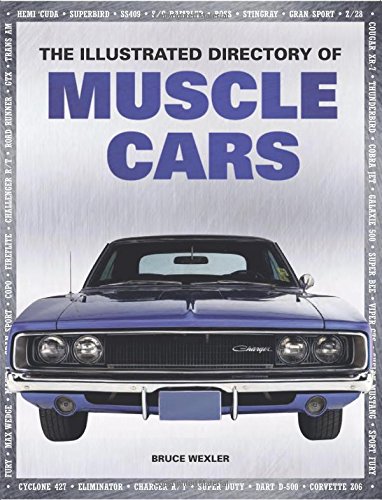Modern car engines are hard to fault… objectively. They start immediately – even when it’s 15 degrees out. They rarely stall out – leaving you dead in the water in the middle of a busy intersection. Most require not much more from you than gas and oil for the first 100,000-plus miles from new.
But when was the last time you turned off the stereo and rolled the window down just to listen to their music? Or proudly popped the hood for your friends?
Not much to see, is there?
You don’t need to be a gearhead to understand.
Ever been in a busy place, like a shopping mall parking lot, and heard the instantly recognizable sound of an old air-cooled VW? We turn to look – and smile, remembering. Anyone who was young in the ’60s knows the distinctive pitch made by a 289 Hi-Po Ford …the low bass rumpa rumpa rumpa of an idling big-block Chevy.
But not all the Great Ones died with the ’60s. Even during the dark days of the 1970s and early ’80s – when high performance cars had been beaten to the verge of extinction by emissions regs and general anti fun-car malaise, there were a few standouts that kept hope alive:
* 1972-79 L-82 Chevy 350:
While the solid lifter-cammed, high-compression LT-1 that powered the 1970 Z28 Camaro and Corvette has claimed much of the limelight and worship of muscle car afficionados, the hydraulic cammed L-82 small-block is equally deserving of applause.
Unlike the LT-1, the L-82 was a survivor. It made it through the catalytic converter/unleaded gas gantlet, leaving the LT-1 to the history books.
Arguably, too, the L-82 was a better all-arounder than the powerful but temperamental LT-1 (which among other things needed to have its mechanical/solid lifter valvetrain adjusted every several thousand miles – or sooner). The L-81 had a no-maintenance hydraulic cam (still a performance grind, too) and a more reasonable compression ratio that tolerated the regular unleaded fuel an LT-1 simply could not abide.
The L-82 was a leas peaky engine, with excellent low and mid-range torque – so it worked well with an automatic transmission. The earlier LT-1, in contrast, came paired only with a manual transmission – and was a beast to live with in stop-and-go traffic
But it had the critical essentials to become a beast, if you so desired – including high-flow cylinder heads similar to the LT-1s. It also always made at least 200 hp (and as much as 240 hp) even during the darkest days of the mid-1970s, when any engine that rated such numbers was a hero, especially when compared to emissions and mileage-neutered V8s that struggled to produce 120 hp. The L-82’s availability on the options sheet kept the Corvette credible after 1975 – when its standard engine, at low ebb, was a 165 hp wheezer unfit for Nova duty and a moral outrage in a car that claimed to be “America’s sports car.”
* 1973-74 Pontiac SD-455:
What made the ’67-’81 Firebirds and Trans-Ams special was their unique, Pontiac-built engines. Nothing wrong with Chevy V8s. They are excellent engines. But they are not Pontiac engines. Without their unique, Pontiac-built V8s, the ’82 and up Firebirds were – mechanically speaking – little more than rebadged Camaros with slightly different exterior panels and trim. But 1981 and earlier Trans-Ams had their own personality, due in large measure to the bigger-than-Chevy-V8s under their shaker scoops. 6.6 liter 400s (and – through 1976 – 7.4 liter 455s) rathe than the 5.7 liter 350s in the Camaro.
There were several memorable Pontiac V8s, but the ’73-’74 Super Duty (SD) 455 was arguably, the last true muscle car V8.
Though it shared its displacement with other Pontiac 455s, it was radically upgraded – beginning with a reinforced heavy duty block unique to the SD – onto which a pair of high-flow (“round port,” in Pontiac lingo) cylinder heads were perched, their big valves actuated by the most aggressive cam profile Pontiac engineers could get away with installing, the works fed by a specially calibrated (and also unique to the SD engines) 800-CFM Rochester 4-barrel carburetor on a medium-riser, dual plane intake. The combo netted 290-310 hp, depending on whose numbers you believe. And put a Trans-Am (or Formula Firebird) so equipped down the quarter mile in the very low 13s, on street tires. On slicks and with a little tuning, these cars could dip into the 12s.
 The Illustrated Direct...
Best Price: $5.54
Buy New $23.15
(as of 10:00 UTC - Details)
The Illustrated Direct...
Best Price: $5.54
Buy New $23.15
(as of 10:00 UTC - Details)
 DURA LUBE HL-40199-06-...
Buy New $60.22
(as of 12:55 UTC - Details)
DURA LUBE HL-40199-06-...
Buy New $60.22
(as of 12:55 UTC - Details)
 DURA LUBE HL-41501-06 ...
Buy New $12.55
(as of 10:35 UTC - Details)
DURA LUBE HL-41501-06 ...
Buy New $12.55
(as of 10:35 UTC - Details)





